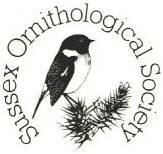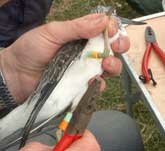
The Ringing Process...
This project is possible because birds can be marked with coloured rings on their legs. The colour combinations are arranged so that any individual bird can be distinguished.

This project is possible because birds can be marked with coloured rings on their legs. The colour combinations are arranged so that any individual bird can be distinguished.
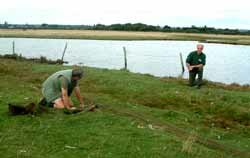 Catches take place annually in autumn in Chichester Harbour, and you can come and help. The pictures on this page were taken during the first project catch, August 2004. We use cannon-nets to catch birds while they are roosting. By this method it is possible to catch a good number of birds at one attempt. You are also more likely to get a representative proportion of adults and juveniles. If mist nets are used you are more likely to catch a disproportionate number of juveniles. All bird ringing involves thorough training and licensing; cannon-netting is particularly tricky so needs expert supervision.
Catches take place annually in autumn in Chichester Harbour, and you can come and help. The pictures on this page were taken during the first project catch, August 2004. We use cannon-nets to catch birds while they are roosting. By this method it is possible to catch a good number of birds at one attempt. You are also more likely to get a representative proportion of adults and juveniles. If mist nets are used you are more likely to catch a disproportionate number of juveniles. All bird ringing involves thorough training and licensing; cannon-netting is particularly tricky so needs expert supervision.
A cannon-net is a large net that is gathered together in a line parallel to the shore and hidden before the expected birds arrive. The front edge of the net is attached to projectiles, which are placed in metal tubes with a gunpowder charge (the cannons) hidden in the ground. Members of the team always survey an area ahead of time, usually for several days, to be able to set the net in an area that is likely to be visited by the birds.
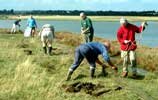 The net is placed in position.
The net is placed in position.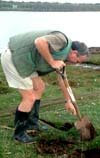 The cannons are dug into the ground and hidden as best as possible. They are aligned so that they fire the net at the correct angle safely above and over the roosting flock of birds. Markers are put out so that the team leader can tell from a distance whether the birds are in the right area to be caught. The cables are connected and tested. The team leader and usually at least one other person conceal themselves in a hide or other suitable place with the firing box, and watch carefully to see what the birds do.
The cannons are dug into the ground and hidden as best as possible. They are aligned so that they fire the net at the correct angle safely above and over the roosting flock of birds. Markers are put out so that the team leader can tell from a distance whether the birds are in the right area to be caught. The cables are connected and tested. The team leader and usually at least one other person conceal themselves in a hide or other suitable place with the firing box, and watch carefully to see what the birds do.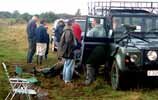 Meanwhile other team members wait in a place nearby where they will not disturb the birds, with fingers crossed that the birds will arrive and put themselves in the right place.
Meanwhile other team members wait in a place nearby where they will not disturb the birds, with fingers crossed that the birds will arrive and put themselves in the right place.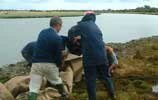 If all goes to plan, and birds settle within the catch area, the net is fired. The projectiles carry the net over the birds, trapping them. All the team members then go as quickly as possible to get the birds out of the net. Material is put over the nets to calm the birds that are waiting to be extracted.
If all goes to plan, and birds settle within the catch area, the net is fired. The projectiles carry the net over the birds, trapping them. All the team members then go as quickly as possible to get the birds out of the net. Material is put over the nets to calm the birds that are waiting to be extracted.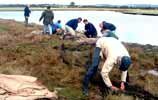
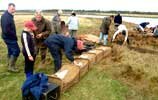 The birds are then put into temporary cages according to species while they wait to be processed. If the catch site is a long way from where they will be processed, they are carried in wooden boxes.
The birds are then put into temporary cages according to species while they wait to be processed. If the catch site is a long way from where they will be processed, they are carried in wooden boxes.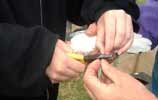
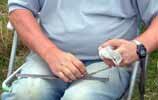
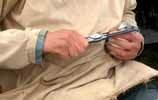
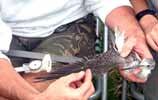
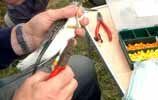
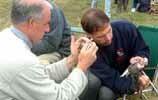
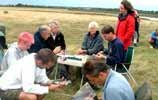
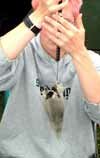
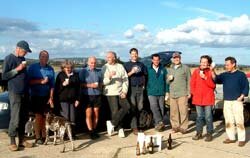 At the end of the day, once everything has been cleared up, we celebrate!
At the end of the day, once everything has been cleared up, we celebrate!
If you see a ringed bird, click here to send us the details. We will send you information about the history of this bird.
Radiotracking
This works by attaching a very small and lightweight transmitter to the bird, which can then be detected by using a hand-held aerial plugged into a radio receiver. Each transmitter operates at a different frequency, so the receiver is tuned to each of these in turn to see if it picks up a signal (in the same way as a household radio can be tuned to different stations). The range is up to about 1km. We also used an automatic datalogger to detect birds flying in and out of the roost site at Thorney Deeps. It was installed at the gatepost at the entrance to Baker Barracks, thanks to the staff of the regiment based there. The data was downloaded periodically onto a computer.
Acknowledgements: The tags were supplied by Biotrack, who also provided helpful advice. Some of the equipment was borrowed from EPR Ecological Planning and Research.
See also the Results page of this website.
![]()
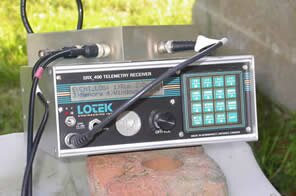


Geolocators
These are miniature light level loggers. The data recorded can be processed to give latitude and longitude. The system does not work during the equinoxes, or where there is continuous daylight. In addition, if the bird is female, and she is incubating, the device does not record light - but it does then show what the bird is doing! The device needs to be taken from the bird in order to download the data, which means it has to be recaptured.
Farlington Ringing Group acknowledges with gratitude the generous sponsors of this project: Migrate Technology (manufacturers; see ), British Birds, Chichester Harbour Conservancy, Sussex Ornithological Society and Hampshire Ornithological Society. Group member Ruth Croger made the rings to take the tags. Thanks to Ron Summers for advice on this.
For news of progress see the website page on the History of the project.
Both images Pete Potts/Ruth Croger


